DJI Mini 2 Review
DJI Mini 2 Review
DJI's entry-level drone just got better
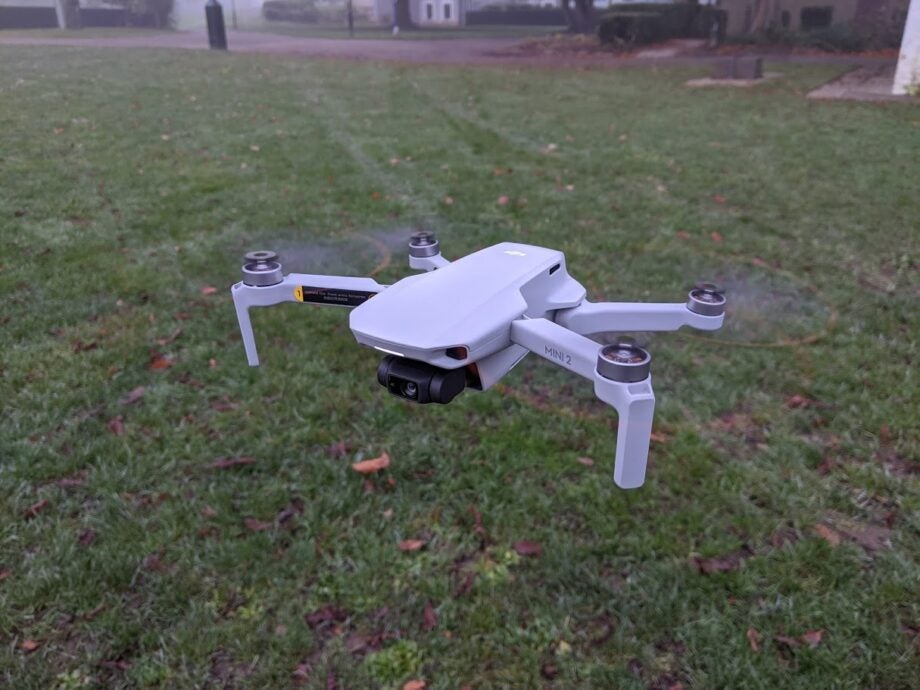
Verdict
I can't remember the last time I had so much fun testing out a product – the DJI Mini 2 is a blast to use, and the simplicity of the accompanying DJI Fly app means that you can pull off incredible shots with ease. The jump to 4K makes this newer model a must-have upgrade over the Mavic Mini, even if the price is a bit more of a hurdle this time around. For vloggers, amateur photographers and video enthusiasts, DJI has created the best entry-level drone out there.
Pros
- Super portable and fairly quiet
- Shoots 4K 30fps
- Incredibly easy to use
Cons
- No sign of DJI's Active Track feature
- Fairly serious price hike
Key Specifications
- Review Price: £419
- <249g
- Maximum speed of 16 m/s
- Maximum distance of 6km
- 31 minute flight time per battery
- Shoots in JPEG and RAW
- Video footage up to 4K 30fps
- 100Mbps
- USB-C
As the successor to the DJI Mavic Mini, the new DJI Mini 2 seeks to make the drone experience even more accessible to the masses.
2020 was a big year for DJI. Hot on the heels on the DJI OM 4 and the DJI Pocket 2, the company released a successor to its entry level drone with the DJI Mini 2, continuing the trend of making enthusiast level filmmaking tools accessible for the average consumer.
At the time of launch, the DJI Mini 2’s lightweight stature at just under 249 grams allowed it to fly under the UK Government’s requirement of declaring ownership over a drone, although this has now changed going into 2021.
While the DJI Mini 2’s unparalleled portability makes it a great drone option for consumers right off the bat (and a solid choice for anyone’s first drone), there’s a lot to know about this new device beyond its weight.
Related: Best Drones
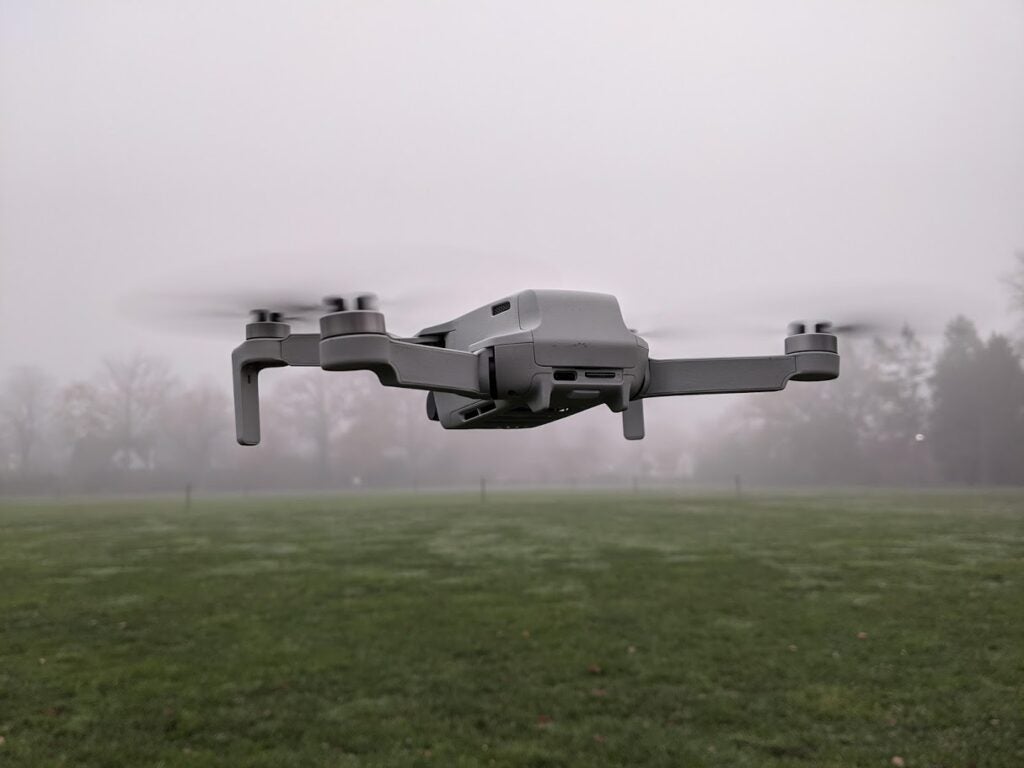
But the standout spec for some will probably be the Mini 2’s notably higher price – £419 for the base model and £549 for the (arguably essential) Fly More Combo pack, which includes a carry case, extra batteries and spare propellers. Compared to the Mavic Mini’s £369 RRP, the DJI Mini 2 will be out of reach for a fair amount of consumers, but for those who can make the stretch, the extra cost is easily justified.
Design – The DJI Mini 2 is portable, compact and sturdy for its size
- Incredibly lightweight for a drone, coming in at just under 249g
- Charging is now done via USB-C
- The controller has been revamped – it’s larger but sturdier in the hand
The DJI Mini 2 brings with it a substantial number of upgrades and new features – but a design overhaul isn’t one of them and I’m glad this is the case. With its lightweight structure coming in at just shy of 249 grams, the Mini 2 is incredibly easy to carry around, but this portability never feels as though its affected the drone’s structural integrity. This is still a sturdy device, albeit in a smaller form factor.
Much like the Mavic Mini, the Mini 2’s arms are tucked away by default for easy storage, and an included belt keeps the whole thing together when not in use. When the time comes to fly, it’s a simple case of removing the belt and then extending the arms in the correct sequence (this is all labelled on the device, so it’s near impossible to make a mess of things).
The only key change on the Mini 2 itself is that it’s finally made the jump to USB-C, doing away with the long-dated Micro-USB port. If you’re looking for innovation, it’s best to turn your attention to the DJI Mini 2’s updated controller, which feels a world away from its predecessor.
Related: Best Cameras
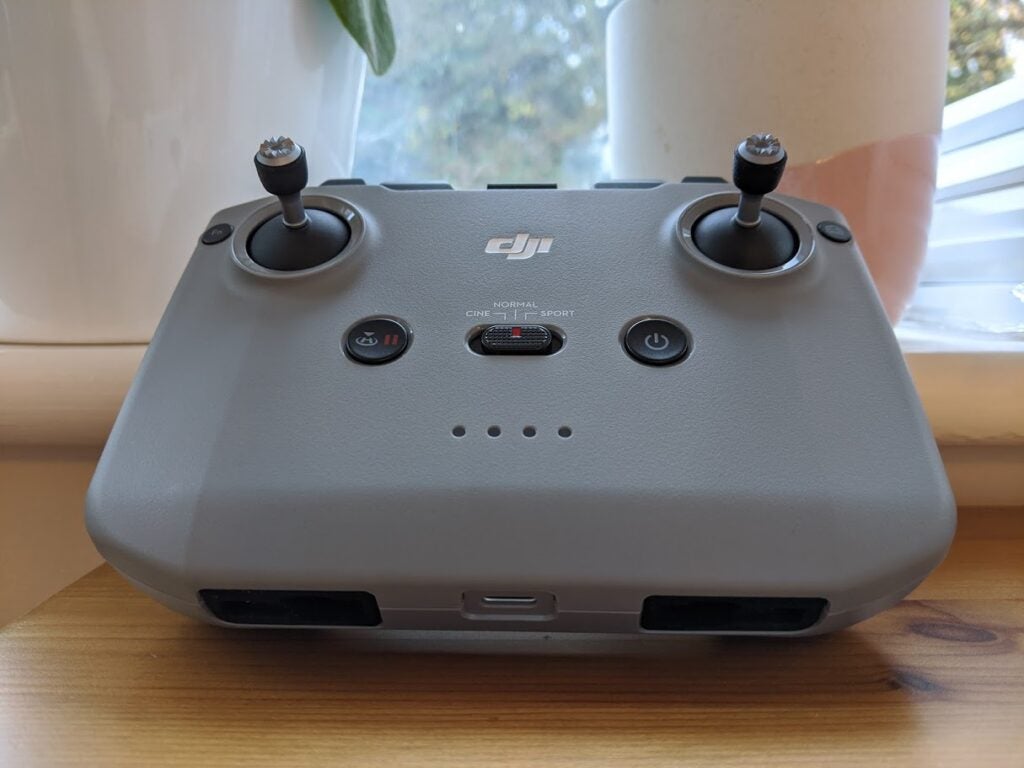
Much like the controller that was bundled with the Mavic Mini, the Mini 2’s controller uses a holster a keep your phone in place during operation, but this time the phone is held just above the controller as opposed to underneath it.
The Mini 2’s controller is a lot beefier as well, giving you a great deal more real estate to hold on to which can feel a tad cumbersome at first but it’s easy enough to get used to. The ability to switch between the drone’s three main movement modes has now been placed on the controller itself, making it easier than ever to jump between them. The right trigger lets you begin recording or take a picture, while the rotating wheel in the left trigger position lets you oscillate the camera whilst in flight.
Features and flight – devilishly simple and now sturdier than ever
- Quickshots makes it incredibly easy to get impressive aerial footage
- DJI’s new OcuSync 2.0 technology has increased the flying distance by 150%
- Active Track – an object tracking feature on other DJI devices – isn’t here
As previously mentioned, DJI does a great job of giving consumers instant access to intricate filming techniques and the DJI Mini 2 is no different. For anyone who feels slightly daunted by the experience of flying a drone – don’t be – the accompanying DJI Fly app takes most of the hard work off your hands.
Once you’re all sorted with the tutorial for manual controls, the ‘Quickshots’ section of the DJI Fly app opens up and this is where the real fun begins. The Quickshots menu includes a bunch of fancy manoeuvres that the DJI Mini 2 can pull off at the touch of a button – although you do have control over how far the drone can go while pulling off these aerial feats.
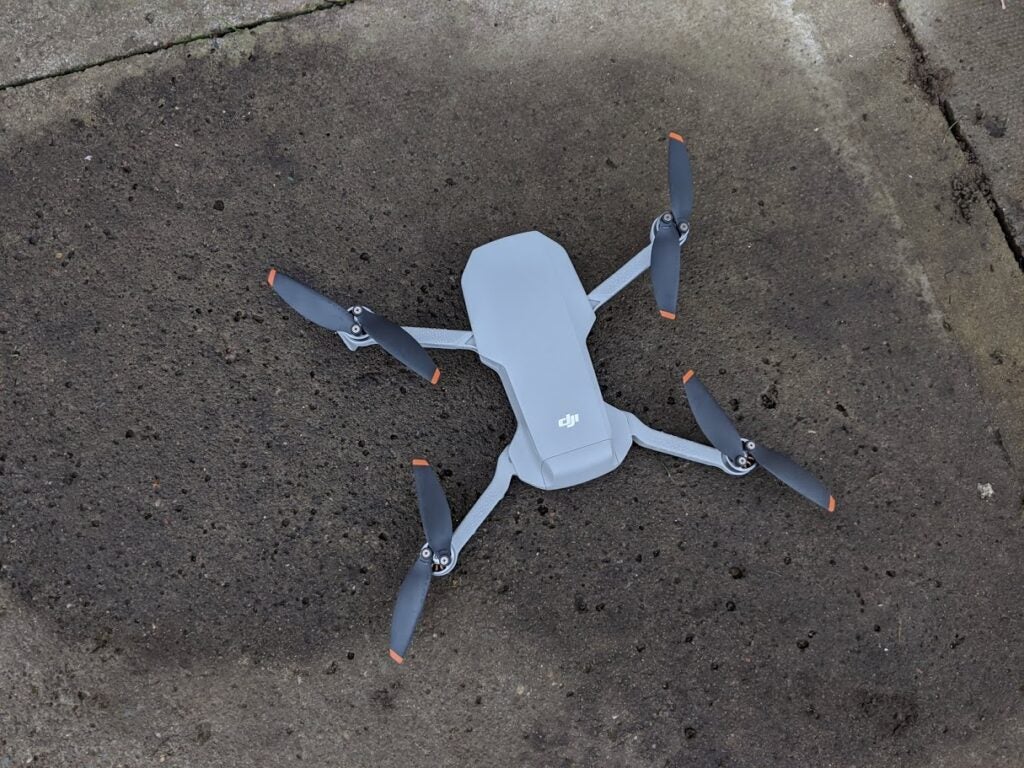
There are five Quickshot modes in total: Dronie, Helix, Rocket, Circle and Boomerang. For the social media obsessed among us, Dronie and Rocket will probably have the most appeal, as the Mini 2 propels itself away from a subject at an angle or straight upward respectively, revealing the surrounding landscape.
Filmmakers on the other hand will feel far more at home with the three remaining modes. Circle does exactly what it says on the tin – steadily move around a highlighted subject until a full circle is complete. Helix and Boomerang are a tad fancier, spiralling around a subject as the drone moves further away, but while Helix completes its journey at a distance, Boomerang keeps the recording going as the drone returns back to its original position.
With these modes at hand, it’s almost impossible not to shoot some genuinely awe-inspiring footage. Having spent some time around professional level drones in the past, I’d be lying if I said I wasn’t slightly nervous about working my way around the Mini 2, but the Quickshots feature not only simplified the process, but it made flying the Mini 2 immediately rewarding.
Helping to achieve this sensation are the new motors found within the DJI Mini 2. While the Mavic Mini could reach a top speed of 13 m/s, the Mini 2 trounces that with up to 16 m/s. The upgraded internals also allow for a higher, Level 5 wind resistance. Time spent testing the Mini 2 also happened to coincide with some particularly windy weather, but the drone didn’t appear to struggle with the conditions. Even a flight session during a heavy fog – where the Mini 2 appeared to jitter about on occasion – still produced stable, high quality footage.
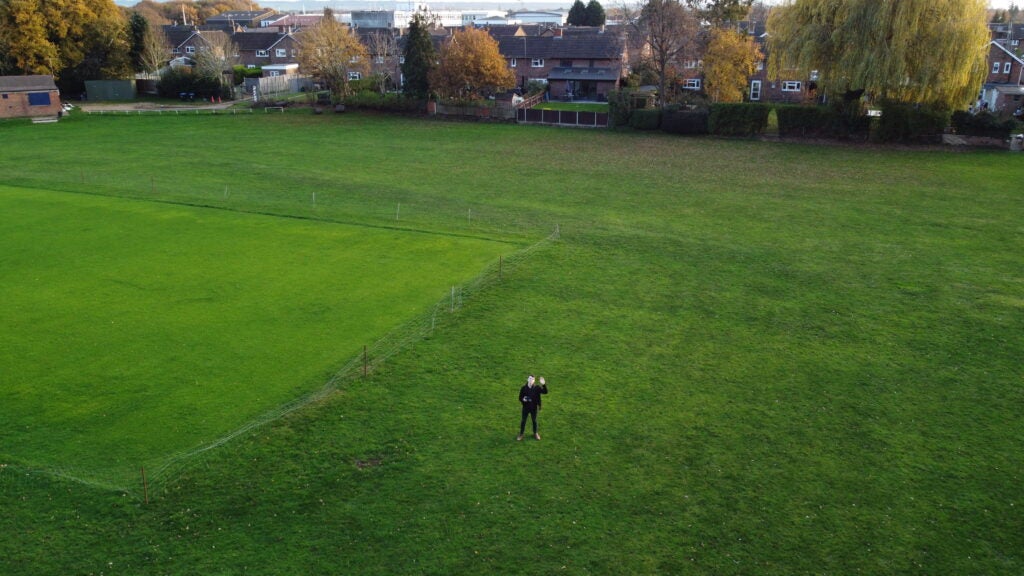
The true icing on the cake however is DJI’s new OcuSync 2.0 technology which, in tandem with the larger controller, allows the Mini 2 to fly as far as 6km away from the user – a distance 150% greater than what was possible with the Mavic Mini. In this regard, the Mavic Mini feels positively ancient, as the Mini 2’s maximum distance is much closer to that of DJI’s higher end drones, and the stunning shots you can achieve as a result of this make it well-worth the upgrade.
The only feature that seems to be missing here is DJI’s Active Track technology. Found in the likes of the DJI OM 4 and the DJI Pocket 2, Active Track lets you keep the camera pointed at a specific subject, no matter where you move to. The Mini 2 does let you highlight a subject during the Quickshots moments, but it would’ve been even better to make use of Active Track during manual flying.
When flying in optimal conditions, DJI notes the Mini 2 as having a battery life of up to 31 minutes, and I found this to be fairly accurate during testing. For the pros out there, 31 minutes should be plenty of time to get all of the aerial footage you need, but even then it’s worth investing in a few extra batteries to avoid missing out on the perfect shot.
Video and image quality – 4K finally comes to the Mini series
- The highest video quality has been bumped from 2.7K to 4K 30fps
- Pictures can be shot in RAW, offering more versatility in editing
- Stabilisation is fantastic, even on windier days
If there was a chip in the Mavic Mini’s near perfect crown, it was undoubtedly that the device capped video recording at a measly 2.7K. Luckily this is no longer an issue, as the DJI Mini 2 can now record at up to 4K 30fps, meaning that it no longer feels as if you’re missing out by opting for DJI’s entry level drone.
The Mini 2 is now able to do justice to whichever location you’re in. For instance, one flying session was during a sunny day and another was on a cold morning clouded by fog, but on both occasions the video quality was sharp and stable, giving me the chance to extract any high-resolution stills images from the recordings.
The increased resolution also comes with the ability of 4x zoom during filming, letting you get even closer to far away subjects that might lie beyond the aforementioned 6km cap. While it’s a nice feature to have, in testing I found the act of controlling the drone itself to be so entertaining that I rarely turned to the zoom function as a necessity.
For budding photographers, you’ll be glad to know that the DJI Mini 2 can now shoot pictures in RAW, as well as JPEG. This allows for far more flexibility in the editing process, which can go a long way to perfecting the type of grand landscape shot that drones excel in.
If you’re a complete newcomer to the drone experience then it is worth pointing out that, for obvious reasons, the DJI Mini 2 doesn’t record audio. It’s not the worst problem in the world however, as it can easily be circumvented with a lapel mic.
There are no bones about it, the DJI Mini 2 is the best entry-level drone you can buy right now. The higher priced drones in DJI’s range will no doubt offer a more robust experience, but for the average consumer – someone looking to buy their first drone or simply expand their vlogging capabilities to the skies – the DJI Mini 2 has everything you need.
Even though there’s a serious price hike to be had over its predecessor, the jump to 4K and the new 6km distance cap make it well worth the upgrade. We do recommend however picking up the Fly More combo pack, as the additional batteries will allow you to make the most out of the Mini 2, and the included carry case is just handy for transporting all the necessary components.
You should buy the DJI Mini 2 if
1. You’re buying your first drone
Given that the DJI Fly app makes the drone experience as simple as a few taps on your smartphone, the DJI Mini 2 is the perfect entry-point for someone looking to get into the world of commercial drones.
2. You want to shoot aerial footage in 4K
The camera on the DJI Mavic Mini was capped at 2.7K, which was hardly ideal if you wanted to combine it with 4K footage filmed elsewhere. But with the DJI Mini 2 able to shoot in 4K 30fps without issue, it’s an easily justified upgrade over the previous model.
3. You need a compact drone that’s easy to take with you
Depending on much money you’re willing to spend, some drones can end up being really hefty and a pain to transport. If you want something small however that’s easy to bring along during a hike, or even on holiday, then the DJI Mini 2 is one of the best options out there.
You should not buy the DJI Mini 2 if
1. You want a professional level drone
It should go without saying that the DJI Mini 2 is intended for the average enthusiast, so if you’re a professional filmmaker looking to expand their capabilities to the skies then you’ll probably want to look elsewhere. Heftier and more capable drones, such as the bulky DJI Phantom series, have more of the bells and whistles to satiate professionals.
2. Active Track is an essential feature for your filmmaking
Despite being available on a wide range of DJI products, the company’s Active Track feature hasn’t found its way to the DJI Mini 2. The feature can be a huge help for vloggers, so if you rely on it consistently for your content, its absence here could put you off purchasing.
3. Your budget is incredibly tight
The one downside of the DJI Mini 2 over its predecessor is the noticeable price hike that goes along with it. With the Mini 2 going above the £400 mark, it’s no longer as financially accessible to consumers, and that’s before you factor in the even more expensive – but arguably necessary – Fly More combo pack.


